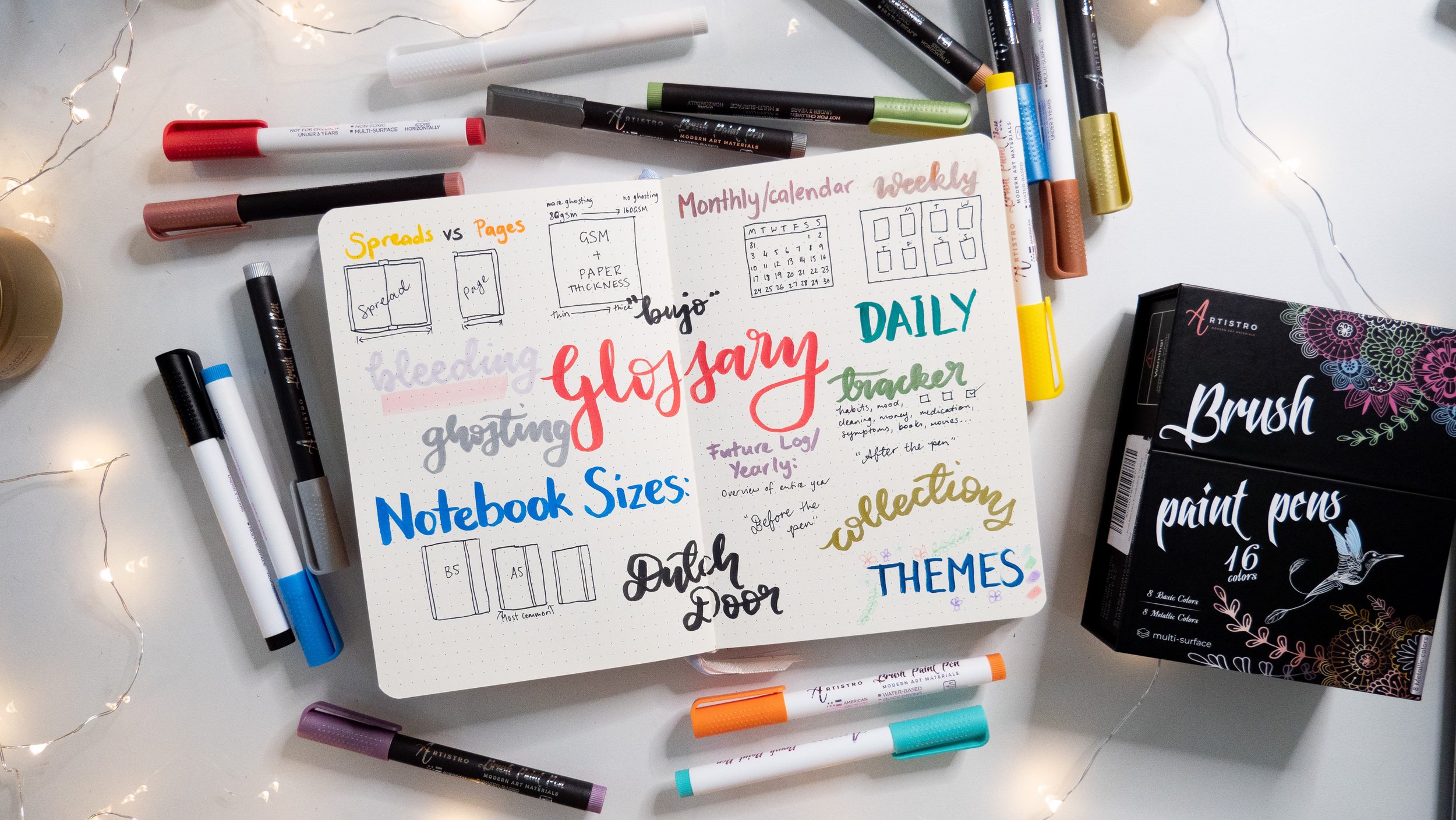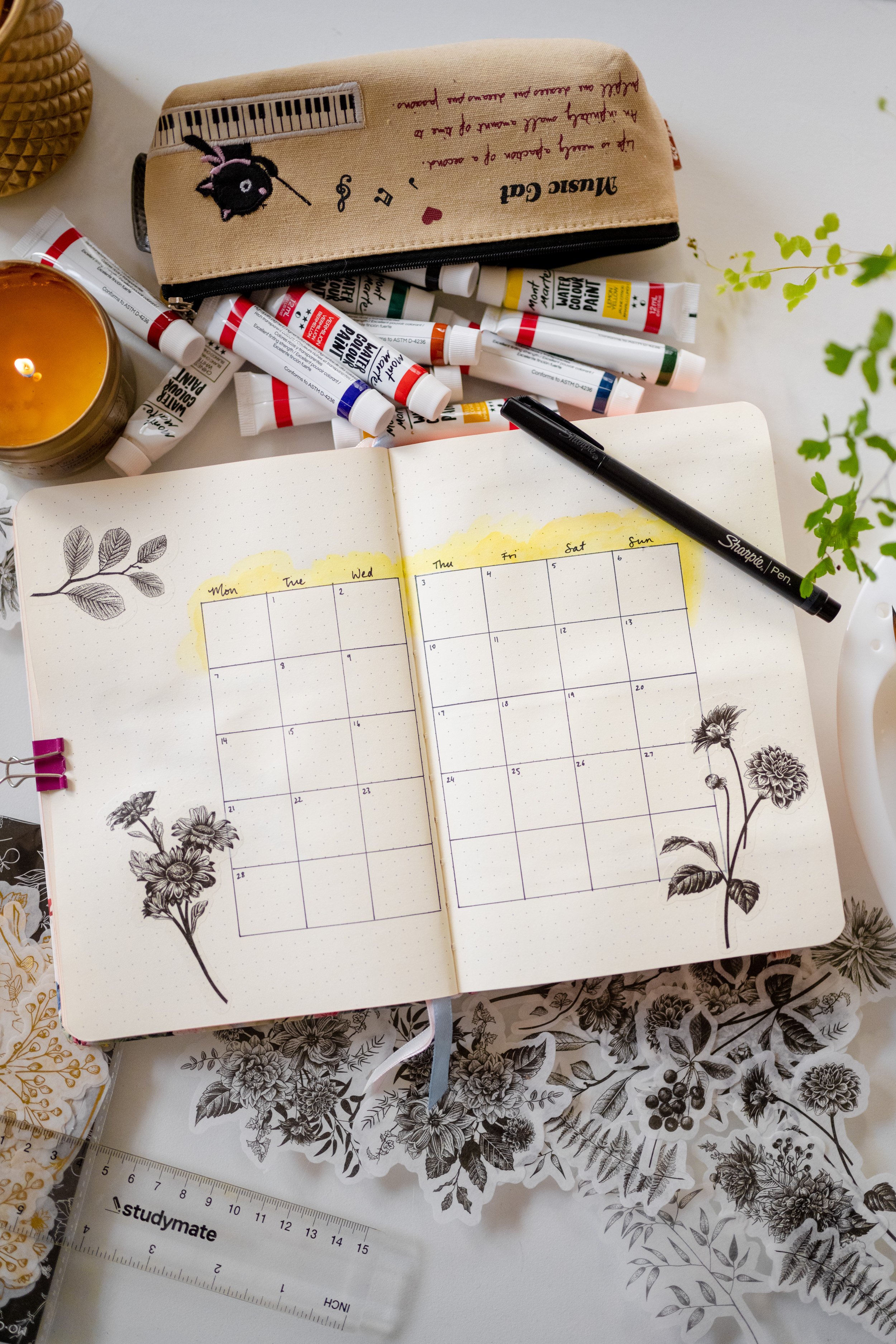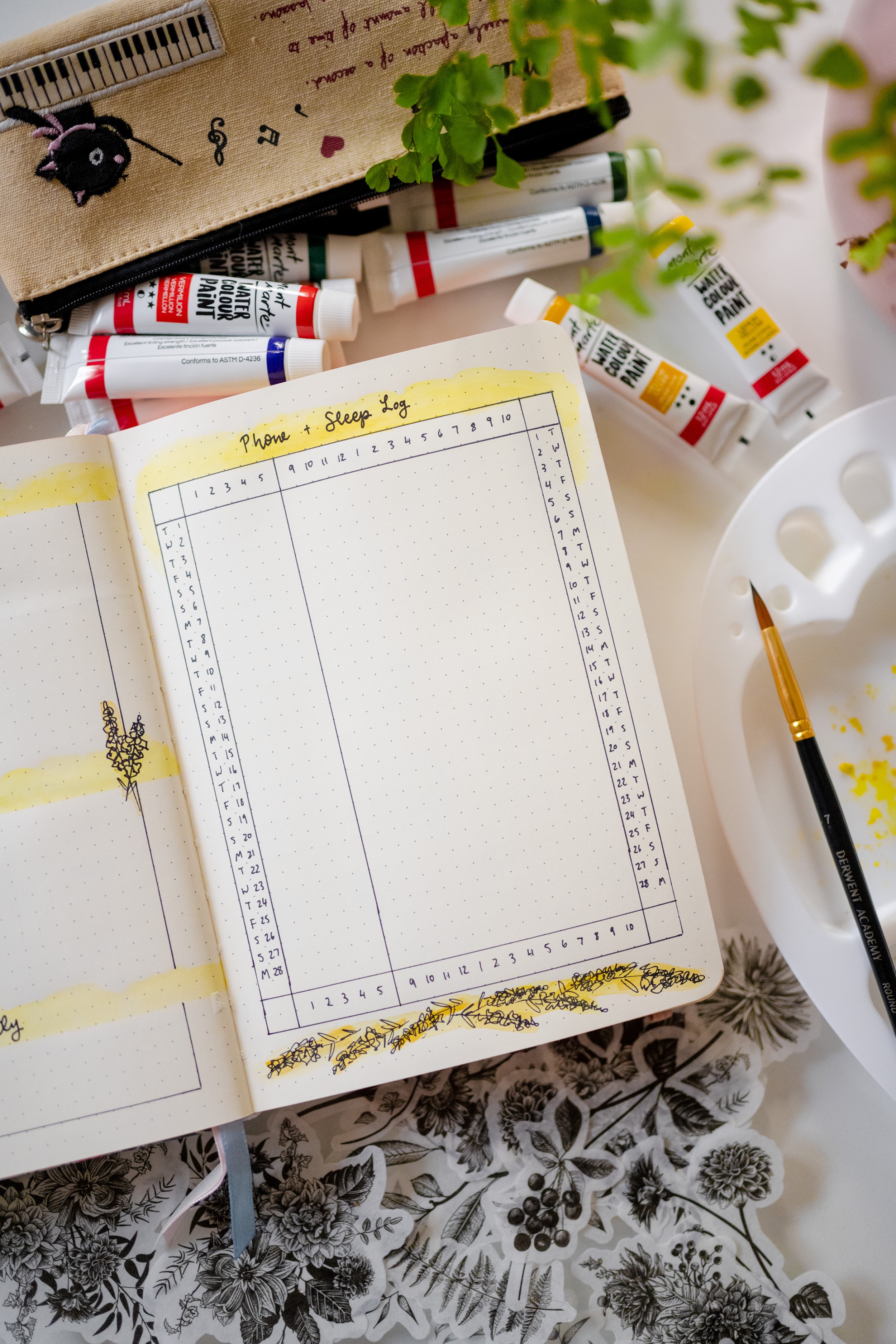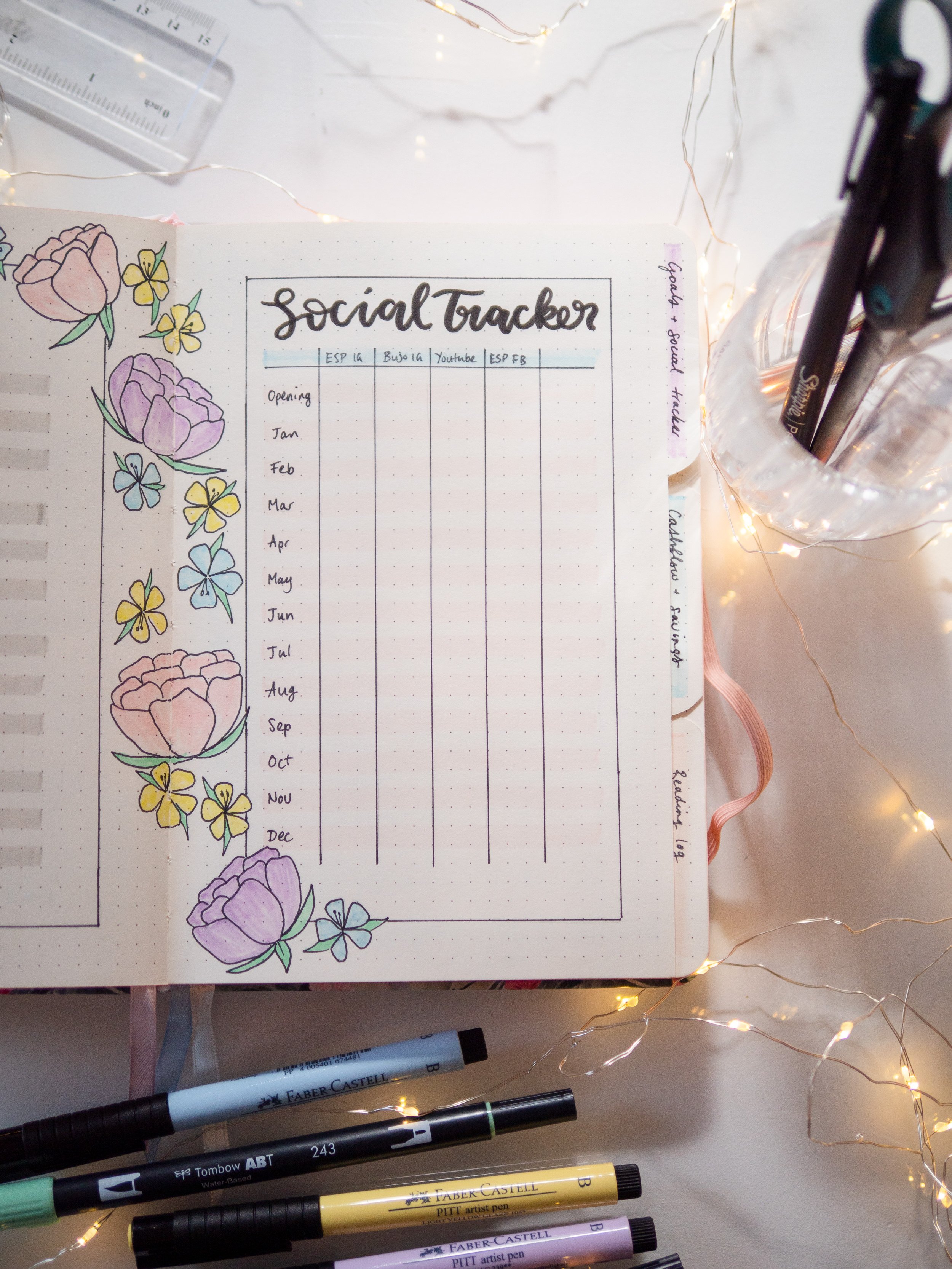Bullet Journal Glossary: What Does It All Mean?
When you first discover bullet journaling, it can seem like there’s a whole new language you need to learn! Spreads, pages, bleeding, ghosting, Dutch doors and journal sizes and GSM - it’s a lot to grasp! If the terms are leaving you overwhelmed and have you procrastinating on starting your first journal, this blog post is for you. By the end of the post (or video, below) you’ll be a total pro with all the journaling words, and you can always refer back later if you need a refresher!
What the heck is a “bujo”?!
OK, fair - this one is pretty obvious, but I wanted to include it anyway because it’s so commonly used. “Bujo” is a portmanteau, which is when you smoosh parts of two words together to make one smaller word. It derives from the first syllables of “bullet” and “journal” - hence bujo.
Dotted notebook/dot grid journal
Why do bullet journal fiends love dotted notebooks so much? The dot grid makes it much easier to plan a balanced and even layout, draw straight lines (even without a ruler) and allows a lot more flexibility on how you use a page than a traditional lined notebook. You absolutely don’t necessarily NEED a dot grid notebook to start a bullet journal - you can use any kind of notebook in any size - but once you go dotted it’s hard to go back!
Notebook sizes: A5, B5 and more
Everyone has their own preference when it comes to notebook size - some like a small and portable journal, others prefer a larger book with plenty of page space. The most common bullet journal notebook size is A5, but B5 and some notebooks smaller than A5 are also popular.
A5 notebooks are 145 x 210mm (or 5.70 x 8.26 inches), and are commonly available in a range of cover designs from a huge range of journal stores. They’re currently my preferred journal size!
One size up from A5 is B5, at 190 x 250mm (or 7.48 x 9.84 inches), which is great if you want a LOT of planning space on your page, but maybe a little less great if you want to carry your journal around with you day to day. They’re also available from most of the popular bullet journal suppliers!
Some brands also stock smaller notebooks, like the Notebook Therapy Tsuki Original Size range. They’re a little smaller than A5, which makes them perfect for popping in your backpack or handbag. I used these smaller journals for the entirety of 2021 and I loved them!
The left notebook, the pink one, is a Notebook Therapy Original Size journal. On the right, the purple one is an A5 notebook.
GSM & paper thickness
Does the thickness of your journal’s paper REALLY matter? To some people, yeah it does! To others, not so much. It depends on how you plan to use the journal!
GSM is a measure of paper thickness - it stands for grams per square metre, so it actually refers to the weight of the paper. The smaller the number, the lighter and thinner the paper - so 80GSM is pretty thin, whereas 160GSM is kind of thick, but not quite cardboard-thick.
The classic Leuchtturm1917 notebook, which is often associated with Ryder Carrol’s original bullet journal method, has lightweight 80GSM paper. Lots of the fancy journals designed for people who use their journal as an artistic outlet, like Notebook Therapy or Archer and Olive, have thicker 160GSM paper, since it holds up better against bleeding and ghosting (which we’ll talk about soon). Some brands offer a thickness in between, like 100GSM or 120GSM. It ultimately comes down to personal preference! I like a 160GSM page since I love using markers and acrylic paint pens in my journal.
Another consideration matters here too - the higher the GSM, the less pages will typically fit in the notebook. An Archer and Olive 160GSM A5 notebook typically has 160 dotted pages, but they do offer a few with 192 pages. Notebook Therapy 160GSM A5 Tsuki journals sport 176 pages. Leuchtturm1917s, with their thinner 80GSM pages, pack a whopping 249 pages into their A5 books. I typically need two 160GSM notebooks to get me through a year, while I could fit a whole year into a Leuchtturm.
Spreads vs pages - what’s the difference?
This is one I see misused a lot, so it’s time to set the story straight.
Spreads
A spread is when your layout - the stuff you added to your blank page - functionally spills across both of the open pages in your notebook. If your monthly calendar starts on the left page, crosses the binding in the centre of the book, and continues on the right page, you can call it a spread. If you’re holding a book or magazine open in your lap, you’re looking down at two pages, or one spread.
Pages
If your layout only takes up space on one side of the binding, it’s a page - not a spread. A page is the individual bit of paper: the one on the left is the left page, the one on the right is the right page.
A lot of people refer to their bujo pages as “spreads” because they’ve heard other people say it and don’t know what it means, but it actually only counts as a spread if your two pages work together for the same goal. The photos below show it pretty clearly - the first is a calendar page, since it only takes up the right page. The second is a calendar spread, since the layout sits on both sides of the binding.
Bleeding and ghosting
Depending on your page GSM and the kind of materials you use in your journal, it’s possible you’ll experience bleeding and ghosting at times. Both are typically avoided by keen bullet journal users, but one is definitely more of a headache than the other!
Ghosting:
Have you ever used a page in a book, then turned it over and been able see what you just wrote or drew through the page? You could still use the page without issue, but there’s a shadow of the previous or the following page there? That’s ghosting - like the previous page is haunting the next one. It happens often in journals with low GSM paper, like the 80GSM pages in Leuchtturm1917 journals, and while some people find it super irritating, it doesn’t necessarily bother others. I used 80GSM journals from 2017 until 2020, and I barely even noticed the ghosting in my books… until I stepped up to a 160GSM journal in the beginning of 2021, and now I think ghosting would drive me crazy if I had to go back!
Bleeding:
If you use the wrong kind of pen in your bullet journal, or go over one part of the page several times with a marker, you may experience bleeding. That’s when the ink soaks through from the side of the page where you placed it, and becomes visible on the opposite side of the page. It will almost look as though you drew on both sides, even though you only used the pen on one side of the page. This is a much more extreme problem than ghosting.
Bleeding in many bullet journals is often caused by using alcohol based markers, or just because your pages are thin, especially if you go over the same spot with a marker more than once. Bleeding may even ruin a previous page or spread you’ve already set up, or make an otherwise blank page unusable on the other side
Future log or yearly
One of the first layouts I always include in a new book is my future log or yearly. This is an overview of your entire year, where you can add information about important dates you need to remember - like birthdays, special events and anniversaries. I like to include things like annual bills too so I can be prepared for them! You’d likely struggle to fit all this information onto a single page, so I like to make mine a spread, or even two spreads.
Writing out the numbers for every single month in the year does make your hand cramp up a bit, but it’s worth it to have this reference to look back to throughout the year.
My 2022 future log or yearly spread, “before the pen”
Monthly or calendar
When a new month is approaching and it’s time to sit down and plan, I’ll take the information from that month on my future log and add it to my monthly or calendar. Sometimes I like to make this a page, sometimes a spread - but it’s always part of my bullet journal each month. Once the calendar is drawn out and the page is decorated, I’ll add in my important dates.
My February 2021 calendar spread, “after the pen”
Weekly
Within the pages most bullet journal users include each month is another time-related layout: the weekly. It’s exactly what it sounds like - an overview of your week, across a single page or spread. This is where I spent most of my time in my journal, adding to-do list items and ticking them off. I like to do all my planning on weekly spreads or pages, and I also typically prefer to use running task lists, rather than adding my tasks to a specific day. There are SO many different ways to set up a weekly - experimentation is the key to finding out what works best for you!
Daily
Some bullet journal users like to take their planning a step further with daily logs, particularly if they use their journal more for traditional journaling purposes - writing about the happenings of your day, your thoughts and feelings, or adding small trackers to each day for things like meals, water intake or step counts. I’m not personally a daily log kind of girl, but you can find plenty of inspiration out there online if the idea appeals to you!
I love setting things up ahead of time - sometimes VERY early - but when it comes to daily logs, I’d recommend you don’t plan out those spaces in advance. You never know how much space you might need for a single day, so rather than estimating and having too much or not enough, setting up dailies as you go ensures you’ll use only as much space in your book as you need. You’ll avoid wasting pages, and ultimately have a very good-looking journal!
A January weekly from 2022
Trackers
This is one of the bullet journal elements that attracted me most at first - the ability to track whatever you want, however you want. Some of the most common bujo trackers are habit trackers, mood trackers and social media growth trackers, but you could track anything at all that you like - spending, savings, sleep, phone use, exercise, skincare, the weather, cleaning. I have a friend with a chronic illness who uses her bullet journal to track her medication, pain and symptoms, which her doctor finds really helpful too! If you can think of it, you can track it!
The way you track is also flexible - I like to track my savings and social media growth over a whole year, so I include this in my initial setup at the beginning of my book and fill in the information on the last day of every month. Habits, sleep and mood tracking I like to do month-to-month, ticking each item off every day (or every few days if I’ve been busy and forgotten).
Collections
Collections are themed pages or spreads where you can organise your thoughts, make lists, or just celebrate a topic that you love. I don’t do a lot of collections myself, but I’ve seen some gorgeous ones - self care ideas for days when you’re feeling down, collections dedicated to favourite songs or artists, lists of things you want to do at some point, but aren’t necessarily pressing, or just a list of your favourite movies - collections can be anything you like!
Dutch Doors
A Dutch door can be a feature of any kind of bullet journal page or spread. It’s when you cut part of a page off so that the page below shows behind it, and it can be purely for aesthetic reasons (like my 2022 cover page) or to make a spread function more efficiently. It sounds counterintuitive - a more efficient spread when you’ve removed part of the page - but it really can work that way! Dutch doors can be cut vertically, horizontally, diagonally - whatever you can think of.
My 2022 Dutch door cover page
Themes
We see a lot of themes in the bullet journal community on Instagram and Youtube - usually themes are a way to demarcate one month in your journal from the next, but some people like to use one theme for their entire journal, and others don’t use themes at all. All ways are valid! I love a theme - I tend to get bored if things look the same all the time, so trying a new theme each month is a good way to keep me coming back to my journal, and it has helped me push my doodle and art skills too! Some months my theme is detailed and involved, while other months it’s just a colour scheme that I like.
“Before the pen” and “after the pen”
More phrases than terms, these can often be seen on Instagram. When a layout is shared when freshly set up, before any of your events, tasks or tracking is added, it’s considered “before the pen” - before you got in there and planned. If you’re sharing it when it’s been lived in and used, with your events, tasks and tracking added, that’s “after the pen”. You might also see some blurred writing on people’s shared posts sometimes - that’s because they’re keeping some personal information private.
Now you know!
I hope you’ve learned something new from this post - let me know in the comments if I’ve missed anything!











